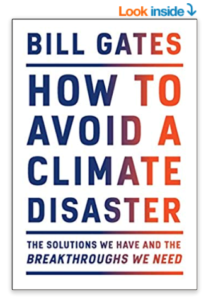No products in the cart.
Posts
How “Avoiding a Climate Disaster” Relates to Career Connected Learning
If you are already familiar with our work at NC3T, you understand that “Career Connected Learning” is the umbrella term for educational strategies to bring career relevance into the learning experience. This Career Connected Learning helps young people think about and plan for the next steps in developing their skills and knowledge toward a career.
Career Connected Learning consists of:
- Career Development Education (spanning from elementary through high school and college),
- Career Connected coursework, and
- Work-based Learning (a broad range of in-school and out-of-school experiences).
These three components together that comprise Career Connected Learning are essential for equipping our youth to make a successful entry into a career and to meaningful contributions to the world through their work.
So how does “avoiding a climate disaster” relate to Career Connected Learning?
I’ll explain. To begin, I just finished reading Bill Gates’ recent book, “How to Avoid a Climate Disaster.” It is well worth reading if you care about understanding the future we and our children will face.
First, if you only know Bill Gates as the founder of Microsoft and one of the world’s richest people, that misses most of what he has been doing during the last 20 years. The philanthropic foundation that he and his wife operate, The Bill and Melinda Gates Foundation, has made important investments toward reducing the impact of disease in poor countries and in improving American education (far from finished!). While I don’t understand or agree with everything the foundation does, I respect his analytical process and commitment to taking on very tough problems.
His work on international health and poverty reduction brought him into direct contact with the implications of climate change, particularly for the poorest families (mostly subsistence farmers) and their vulnerable communities.
So, in his typical fashion, when he decided he needed to understand climate change, Gates read voraciously, talked with dozens of experts, and also began to invest his fortune into new technologies related to averting climate disaster.
He decided to communicate what he had learned and the implications he derived. In writing this book, he has summarized and explained the basic science, and offers a set of recommendations for action. I like his plain spoken and realistic take on the world. He doesn’t categorize people as either villains or heroes. He simply talks about the way that people, governments and markets make decisions that are not usually nefarious; but these decisions are usually short-term in nature and; therefore, have some long-term consequences that on the aggregate, could be terrible.
His basic premise is this – yes, we can and should implement as many green and clean technologies that currently exist. But to raise standards of living across the world and at the same time, save our natural environment from disaster, we need to generate a lot of new electricity and get to “Carbon Net Zero.” He means that first among the rich nations, then the middle-income nations, then the less developed nations over the coming decades, we need to have net zero carbon emissions going into the atmosphere. That means we need to drastically reduce emissions, and for any carbon that is created, we also need technologies for pulling carbon out of the atmosphere.
Creating more carbon-neutral electricity for developing nations will require breakthrough technology innovations. At the same time, we need to replace fossil fuels and eliminate other big sources of greenhouse gases in manufacturing processes for concrete, steel, plastics and fertilizers. We also need to create good substitutes for meat, since cows also create enormous amounts of methane through burping and farting!
From this list of recommendations, here is the dotted line to Career Connected Learning.
All this innovation will have tremendous implications across EVERY sector of industry, and EVERY career cluster!
Here is an incomplete list of how climate-technologies relate to career fields.
- Automotive technicians will maintain a mostly electric fleet of cars, SUVs and trucks, but for the next few decades, they will be maintaining both internal combustion and electric vehicles.
- Agriscience scientists and technicians will develop lab-generated meats, meat substitutes, and genetic modifications to animals to generate less methane.
- Manufacturing engineers and technicians will implement new ways of manufacturing steel, concrete and fertilizers.
- Energy technicians will deploy new carbon-capture and carbon-storage technologies.
- Electricians and home builders will install solar installations and home battery systems.
- Policymakers will create and monitor policies that set targets and incentives, invest in basic technology-neutral R&D, while engaging the public to build understanding and support for smart policies.
- Communications professionals and journalists will be investigating and reporting about the basic climate science and necessary technology innovations and uncover fraud and abuse that might derail good public policies.
Throughout the book, Gates reminds us that this move toward net-zero emissions will be hard.
The “easy” stuff is already happening or is well along the way to large scale implementation. Think about installing LED lights, turning down the thermostats, driving electric cars, and erecting wind turbines and solar panels. These are essential but will not nearly be enough change to cut greenhouse gases to zero. That’s the innovation gap that needs to be filled by basic research and development, commercialization of promising technologies, and aligned governmental policies.
As a book, “How to Avoid a Climate Disaster” is an excellent reality check, a pretty easy read, and avoids the “end of the world” hyperbole and demonizing certain classes of people that can be a turn-off. It carries a healthy respect and appreciation for the free-market capitalism and the role of informed and creative public policy.
I would particularly recommend the book for study and discussion among teachers and teens and young adults interested in history, economics, governmental policy, agriculture, science, engineering, manufacturing, construction, and transportation technologies. Also, teachers and students with an interest in finance will benefit, since the private capital markets also have a significant role to play in commercializing breakthrough R&D discoveries.
Suffice it to say, this is an important book. The topic of climate science and the breakthrough technologies we need is an excellent jumping off point to help educators and students to understand how this will reshape career paths for decades to come.
That’s the connection between climate change and “Career Connected Learning.” Enjoy a good read!
RECEIVE OUR NEWSLETTER
By the way, if you want to stay connected with me and our work, sign up here for our twice monthly newsletter, Engage.Connect.
Hans Meeder is President of the National Center for College and Career Transitions (NC3T) (www.nc3t.com). NC3T provides planning, coaching, technical assistance, and tools. These strategies help community-based leadership teams plan and implement their college-career pathway systems and strengthen employer connections with education.

